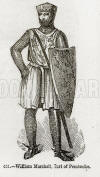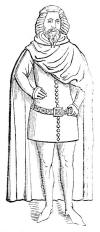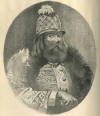Origin of the County
Carlow Coat of Arms
 The arms have strong
associations with the Butler family. Like the
arms of Kilkenny and Tipperary the field is
ermine and for the same reasons. The two
English lions signify that the Butlers held
their land from the English crown. The
rampant lion comes from the arms of another
Butler family from Garrybunden in the County.
The arms have strong
associations with the Butler family. Like the
arms of Kilkenny and Tipperary the field is
ermine and for the same reasons. The two
English lions signify that the Butlers held
their land from the English crown. The
rampant lion comes from the arms of another
Butler family from Garrybunden in the County.
(Source: "Up Tullow
Street" an article in The Advertiser by Michael Purcell c 1992. Carlow
in Old Pictures & Carlow in Old Pictures Vol 2 by Michael Purcell & The
Official Guide to Carlow 1985-86.)
A Norman Frontier Post
Carlow takes its name from the Irish
word 'Catherlagh', referring to a large rock at the centre of
the town which was once surrounded by water. The Normans erected
a timber castle here in about 1180 but it was inevitably burned
down by disgruntled clansmen in the surrounding neighbourhood.
How did they light fires in those days anyhow? At any rate, the
Normans duly twigged that stone castles fare better than wooden
ones and so a new and rather large castle was erected between
1207 and 1213 by Strongbow's son-in-law, the celebrated jousting
champion and all round chivalrous knight,
William Marshall,
Earl of Pembroke. The castle was of immense strategic value to
the Norman conquest of Ireland being located in the heart of the
MacMurrough kingdom (ie: the former kingdom of Strongbow's
father-in-law Dermot MacMurrough, King of Leinster) as well as
affording a strategic crossing point across the River Barrow.
The town was walled in 1361 by Lionel, Duke of Clarence. Less
than 50 years later, Art MacMurrough, ancestral King of
Leinster, captured both town and castle and burned the entirety.
During the Desmond Wars against Queen Elizabeth I's army, Carlow
was again captured, in 1577, by Rory Og O More.
Source: Turtle Bumbery
|
|

William Marshall, Earl of
Pembroke
1146 or 1147 – 14 May 1219 |

Lionel Duke of Clarence
1338 - 1368 |

Rory Og O'More
1537 - 1578
|
|
CARLOW TOKENS
- Below
are three of the merchants tokens struck in Carlow in the
seventeenth century.
(source: Carlow, The Manor & Town by
Thomas King)
|
|

Edward Reynolds |

Garret Quigley |

John Masters |
|
CARLOW 1798
Although not generally welcomed in the county
or the garrison town of Carlow, there were approximately 11,000
members of the United Irishmen in the County by 1798. As part of
an overall strategy for a rising, Carlow town was attacked by
2,000 rebels on 25th May 1798. The plan was doomed to failure
because informers had made known the plot to the defenders of the
town. A small number of yeomen were placed at the entrance to the
town with orders to retreat on the appearance of the rebels.
This
was to encourage the rebels to break ranks and drop their guard.
The plan worked, the rebel divisions advanced so rapidly that they
were a disordered mass by the time they entered Tullow Street and
the Potato Market, where the whole place seemed deserted. Elated
by what looked to be an easy victory they commenced cheering as a
signal for their friends to join them.
The answer to the 'roar of
a thousand voices' was a tremendous volley of musketry from every
window and roof top. Surrounded on all sides 'the town became like
a slaughter house'. Every vantage point had been occupied in such
a way as to lure the rebels to their doom. Many lost their lives,
actual number is unknown. There were no fatalities recorded on the
side of the defenders. The dead were unceremoniously dumped in a
gravel pit, now know as the Croppies Grave in Graiguecullen.
The town was so gallantly defended by a small
party of the military, stationed in the barracks within the town,
that they were repulsed with very great loss; forty-eight men, and
several rebel officers were taken prisoners, and executed a few
days afterwards. In this attack, upwards of eighty houses were
burned to the ground. A handsome monument rises above the site of
an old sand pit where in the aftermath of the disastrous rising of
the United Irishmen in 1798, the bodies of 640 Carlow insurgents
were slaughtered and were then thrown into a gravel pit and
covered with quick lime in a mass grave at Graiguecullen. The
grave is now known as the "Croppies Grave". The monument stands as
testimony to those who gave their lives to further the cause of
freedom from a harsh regime.
Croppies was the name given to the United
Irishmen after the habit of cropping their hair to mark their
allegiance to the cause.